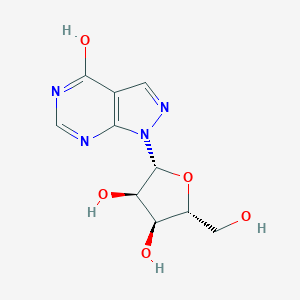| General Information of MET (ID: META00781) |
| Name |
Allopurinol riboside
|
| Synonyms |
Click to Show/Hide Synonyms of This Metabolite
4-Hydroxy[3,4-D]pyrazolopyrimidine riboside; Allopurinol ribonucleoside; Allopurinol-1-ribonucleoside
|
| Source |
Endogenous;Food
|
| Structure Type |
Pyrazolo[3,4-d]pyrimidine glycosides (Click to Show/Hide the Complete Structure Type Hierarchy)
Nucleosides, nucleotides, and analogues
Pyrazolo[3,4-d]pyrimidine glycosides
|
| PubChem CID |
|
| HMDB ID |
|
| Formula |
C10H12N4O5
|
| Structure |
<iframe style="width: 300px; height: 300px;" frameborder="0" src="https://embed.molview.org/v1/?mode=balls&cid=5273534"></iframe>
|
 |
|
3D MOL
|
2D MOL
|
|
Click to Show/Hide the Molecular/Functional Data (External Links/Property/Function) of This Metabolite
|
| ChEBI ID |
|
| FooDB ID |
|
| ChemSpider ID |
|
| METLIN ID |
|
| Physicochemical Properties |
Molecular Weight |
268.2261 |
Topological Polar Surface Area |
N.A. |
| XlogP |
N.A. |
Complexity |
N.A. |
| Heavy Atom Count |
N.A. |
Rotatable Bond Count |
N.A. |
| Hydrogen Bond Donor Count |
N.A. |
Hydrogen Bond Acceptor Count |
N.A. |
| Function |
Allopurinol is an analog of the natural purines in the body, and is quickly metabolized to oxypurines which is also a xanthine oxidase inhibitor. Allopurinol is a white, powdery drug used to treat gout. Its use in the United States was started in 1964. It is an isomer of hypoxanthine and inhibits the production of uric acid, the metabolite responsible for gout, by inhibiting the enzyme xanthine oxidase. The side effects of high levels of precursors are usually minor. A small percentage of people develop a rash and must discontinue this drug. The most serious adverse event is a hypersensitivity syndrome consisting of fever, skin rash, eosinophilia, hepatitis, and worsening renal function. In some cases, allopurinol hypersensitivity syndrome.
|
|
Regulatory Network
|
|
|
|
|
|
|
|
|
 click to show the details of this protein
click to show the details of this protein
 click to show the details of experiment for validating this pair
click to show the details of experiment for validating this pair

